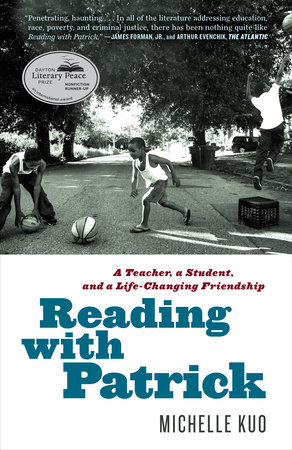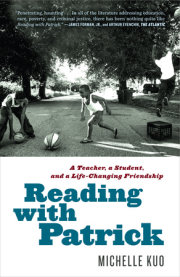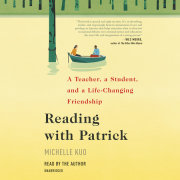***This excerpt is from an advance uncorrected copy proof***
Copyright © 2017 Michelle Kuo
Chapter 1
A Raisin in the Sun
Where Helena sits on the banks of the Mississippi, the river is quiet, peaceable. Summer songbirds talk with frogs, with a tsee tsee tew tew cheer cheer. Wild dewberries bloom on the bluffs, where they dangle, ripe but unplucked. In the water below, catfish form shadows, ready to gorge on what the wind shakes in. For thousands of years the river routinely flooded these banks, building the most fertile soil in the world. In the mid-nineteenth century, plantation owners yielded from this soil a single crop—cotton—and cotton made it slave country.
Slave owners in the Delta were the richest moguls in the nation, and the wealthiest 10 percent of Arkansas’s population owned 70 percent of its land. Steamboats competed with railroads to transport cotton from Helena. After the Civil War, the lumber industry took off, and the swampy hardwoods in the Delta offered yet another source of wealth. People flocked here for wages at the twenty-four sawmills and the docks, the fish fries and the juke joints, the opera house and the saloons. Toss dice, haul wood, make moonshine, repeat. Helena was, as Twain wrote in 1883, the prettiest situation on the river and the commercial center of a broad and prosperous region.
In 2004, the year I arrived in Helena, Twain’s city was hard to imagine. On Cherry Street, the town’s main drag, wooden planks covered windows. There was a No Loitering sign on an abandoned storefront even though the actual loiterers were across the street, hovering around the town’s only liquor store. The marquee of a long-shuttered store had become the canvas of a prankster: Starbucks Coming Soon. Sincerity was more likely to be found on the marquees of churches, which abounded. No such thing as rehab without Jesus, said one. There was no coffee shop, no bookstore, no movie theater, and no more than a handful of restaurants. When I asked where to get good coffee, people recommended McDonald’s. (It wasn’t bad.)
Helena had begun an effort to market an enchanting part of its history, the blues, at the old train depot, which was converted to a museum. The museum shares stories and photos of black musicians who sang in Helena, lived in Helena, visited Helena, used Helena as a stepping-stone to Chicago, or retired in Helena when Chicago didn’t work out. Their names are evocative, often involving infirmity or animals: Blind Lemon Jefferson, Howlin’ Wolf, Super Chikan. Exhibits here have hopeful titles—A Heritage of Determination, reads one, or Struggle in a Bountiful Land—but few visitors.
People say Helena’s decline truly began with the closing of Mohawk Rubber and Tire Company. When it shut down in 1979, the middle class, both black and white, fled. Then Arkla Chemical, a fertilizer company, was shuttered. The bowling alley, the movie theaters, the shops, and the nicer restaurants followed suit. Those who grew up here left, trying to find jobs in Little Rock, Memphis, Fayetteville, or Texas; families stopped coming here to live. When I first arrived in Helena, I worried what locals would think of teachers who left the community after Teach For America’s standard two years. But soon I realized my question presumed that leaving was novel to the experience of living in Helena. What was novel was that young teachers would travel here at all. “The saddest day is high school graduation,” one grandparent would later tell me, referring to the kids who had found opportunities elsewhere, “because those kids won’t come back.”
People here got what jobs they could. Old men knocked on doors, asking to pick up sticks in the yard for money. The guard at the county jail also worked part-time at McDonald’s. A big employer was the casino, technically in Mississippi, just across the river. Funerals provided a steady stream of business. If you drove down Plaza Avenue, on a block no longer than half a mile, there were three funeral homes, a tombstone store, and a flower shop. On a lawn in front of a store, large blank headstones lay flat, reflecting the light. Walmart also did well. On any given school day, teenage girls could be found browsing the many aisles of its baby section. (Outside—on weekends—the high school church group peddled abstinence pamphlets.) Phillips County, of which Helena is the seat, was one of the poorest counties in the country, and ranked last in the state of Arkansas in public health. Its teenage birthrate was higher than that of ninety-four developing countries. There were regular shoot-outs in town. Drugs were a problem, and police officers were busted by the feds for trafficking.
White people did live, eat, and work here, but their children were hard to spot in daylight. They attended DeSoto School, one of many private schools in the Delta established to circumvent integration. When DeSoto was opened in 1970, a dedicated cohort of white families deliberately sent their children to the newly integrated public schools, which flourished in their early years: Helena’s basketball team, a pretty picture of black and white players, became one of the best in the state. But as the economy tanked, property values plummeted, and everybody fled Helena, DeSoto—at first a minority bastion of racists—transformed into an evacuation site for the remaining white families. Helena’s public schools, Central High School and Eliza Miller, are 99 percent black. As of this writing, DeSoto has yet to matriculate a single black student. Thus, in a city so small that the combined graduating class of its high schools is fewer than two hundred students and so remote that one must drive a hundred miles to see a movie, two groups of kids grow up, one white and one black, rarely interacting.
My first months in the Stars classroom had a surreal aspect. Most students had never encountered an Asian person before, and they stared. “What you is?” they’d say, and then, with a serious expression, ask if I was related to Jackie Chan. (Others, less polite, said, “Fuck you, Chinese bitch.”) Once, a sixteen-year-old student took a piss in a classroom, on a dare. Another kid came to school with his legs covered with welts from a switch. “Should I call child services?” I asked other teachers. No, no; that was just how you kept discipline around here. When kids got in trouble at school, it was universally known, they preferred paddling to suspension. “They’re used to that,” the secretary explained to me. “And they don’t want to go home.”
I was shocked by all of this, but I was shocked, primarily, by myself. I yelled. I got mean. At first I tried to appear strict, in a bid to be taken seriously, but this contortion took on a life of its own. To the twelfth grader who called me a Chinese bitch, I said he’d be lucky if he got a job at McDonald’s. To a boy who told a girl she was fat, I snapped, “So are you.” I tore up a student’s drawing, which I’d thought of as a doodle, in order to jolt him into paying attention; he never forgave me, and I will regret it forever. I bribed a mother to sign a permission slip for a field trip. The mother, an absentee drug addict, was angry at her daughter, my student, for calling child services on behalf of her younger siblings. I went to the house. The mother said she’d sign the form if I got her a color TV. We compromised: I’d go to Walmart and get her a kiddie pool. (“Your children are gonna love this,” said the cashier at Walmart, shoving my purchase into a huge plastic bag. “Days get hot here.”) Another time a kid grabbed my butt, and I sent him to the principal; she asked me, “Paddling or suspension?” I told her, “Let him decide.” He chose paddling.
I began to speculate that the modern Delta did not exist in the American consciousness because it disturbed the mind. It crushed part of our American mythology. What had the Civil Rights Movement been for—the violence, the martyrs, the passionate actions—if its birthplace was still poor, still segregated, still in need of dramatic social change? A world of meaning had been built and had now collapsed. Here, one began to worry that the movement was a fabrication of the nation’s imagination. And indeed, much later, a sixteen-year-old boy, whose older brother had been killed by a white man while robbing a flower shop, would approach my poster of Martin Luther King’s March on Washington with genuine suspicion. He put his face right up to the photograph so that his nose touched an image of white protesters in the crowd.
“You made that up,” he told me.
“What?” I asked, confused.
“White people ain’t gonna help no black people.” He believed I’d photographically doctored the photo.
That first semester of teaching was so relentlessly challenging that I barely recognized the cliché I was enacting: middle-class outsider visits, shudders.
I was constantly making classroom rules that I then constantly modified. Raise your hand. Don’t curse. Don’t put down your classmates. Don’t use the word faggot. Don’t slap—don’t poke—just don’t touch anybody. Never put your head down. If you put down your head for the whole class, you get a zero. For most infractions, students would get a “warning.” If they got two warnings, they’d have to go to the corner, where they wrote a “reflection” or, if applicable, an apology. If they refused, I sent them to the principal. This had worked in my summer training in Houston. But the students here were older and, having been subjected to much worse punishment, didn’t care. They had perfect behavior in one circumstance: when our school police officer occasionally stepped into our room. (We had no guidance counselor, no music or art teacher, no functioning library, no gymnasium, no sports teams—or any teams, for that matter—but we did have him.) His presence transformed the class: Whenever he stood there in his blue uniform, his baton hanging from his belt, the kids suddenly became deeply absorbed in whatever I was trying to say. From across the room, the officer winked at me.
I began to distrust my own system. I distrusted punishment. Should a person who forgot to raise his hand suffer the same consequence—a warning—as a person who called another dumb? Shouldn’t the word faggot trigger a collective, “Kumbaya”-type discussion rather than a targeted reprimand? Distracted by issues of discipline—the police, the paddling, my own inner Mr. Hyde—I’d suddenly remember to ask myself what I actually hoped to teach. What did I want students to learn? I was an English teacher, but it seemed I could go days without thinking about a book.
A book—even the word seemed outmoded in Helena. Before school began, the Stars principal had warned me that the eighth graders were reading at a fourth- or fifth-grade level and that I, accordingly, should find appropriate “content.” I either did not understand or did not want to know what this meant. So I gave my class a James Baldwin short story, and they got frustrated because the language was too hard. I gave them a speech by Malcolm X, hoping to rile them up, but it bored them. And I showed them a video of a young state senator named Barack Obama, who had just made a splash at the 2004 Democratic National Convention. “My father was a foreign student, born and raised in a small village in Kenya.” Everything about Obama’s speech, its historical references and its exhortations, seemed too distant for them to grasp.
What was I doing wrong? I wondered. Was it purely a matter of reading comprehension? Historical blind spots? My lack of control over the classroom? My inability to connect with them? I became afraid to share any piece of writing in the black tradition that I considered precious. If it meant nothing to them, maybe it should mean less to me. Deciding to try one last time, I introduced Lorraine Hansberry’s A Raisin in the Sun. Characters spoke to each other directly, the reading level was easier, the format—a play—was new to them, and the story centered on a black family.
It was a hit. The angry banter between Walter and Ruth, husband and wife, got laughs. Their complaints about living in a crowded house got nods. Ruth’s despair over discovering she’s pregnant made the room go silent. And the students universally loved the grandma: All seemed to know her. Born in Mississippi and religious, she scolded her son for wanting to start a liquor store, slapped her daughter for saying there is no God, and yelled at her daughter-in-law for wanting an abortion. As I assigned parts, the students clamored to be cast in her role. “She don’t play,” they said admiringly.
Why, I asked the students, did they think the grandma had left Mississippi to move to Chicago?
“Because there isn’t much for us down here,” one student said easily, and I felt vertigo at the word us. Others nodded in easy agreement.
For the first time, our conversation about American history was not a strain. Usually the students were so handicapped by a lack of basic knowledge that we made no progress. They hadn’t known, for instance, when slavery ended or recognized the vocabulary word emancipation. They hadn’t known that promises to give former slaves land had been broken. They’d vaguely heard about violence against black people in the Delta, but most didn’t know about the massacres of black sharecroppers who had tried to organize in our county, nor did they recognize the word lynching. But this one question, why a black family would leave the Delta, was not difficult for them to answer.
I talked about Helena’s history of violence, which was a taboo topic—for people black and white—in town. This violence, I said, helped drive the mass migration to cities like Chicago. I talked about governments that stood by or even participated in the intimidation of black people. And I passed around a picture of a lynching, a dangling body burned and charred, its edges eerily blotted out. If my students could see how brutal the conditions were, I thought, they might find a channel for their anger and a reason for pride in the history of black resilience.
“This isn’t right,” said one student, looking disgusted. He passed it on. Another studied it and shook his head wordlessly. Then he, too, passed it on.
Their twin emotions, outrage and sobriety, formed for me a coherent whole. When I learned about lynching in middle school, indignation had made me feel powerful.
Then the photograph stopped at David, a spindly kid who lived with his grandmother and liked to sketch animals. He gazed at the picture and did not move. He looked as if he had stopped breathing. Then he turned over the picture and put his head down.
My neck burned; a knot grew hard in my stomach. It was against my rules to put your head down. The students watched and saw my weakness.
. All rights reserved. No part of this excerpt may be reproduced or reprinted without permission in writing from the publisher.





